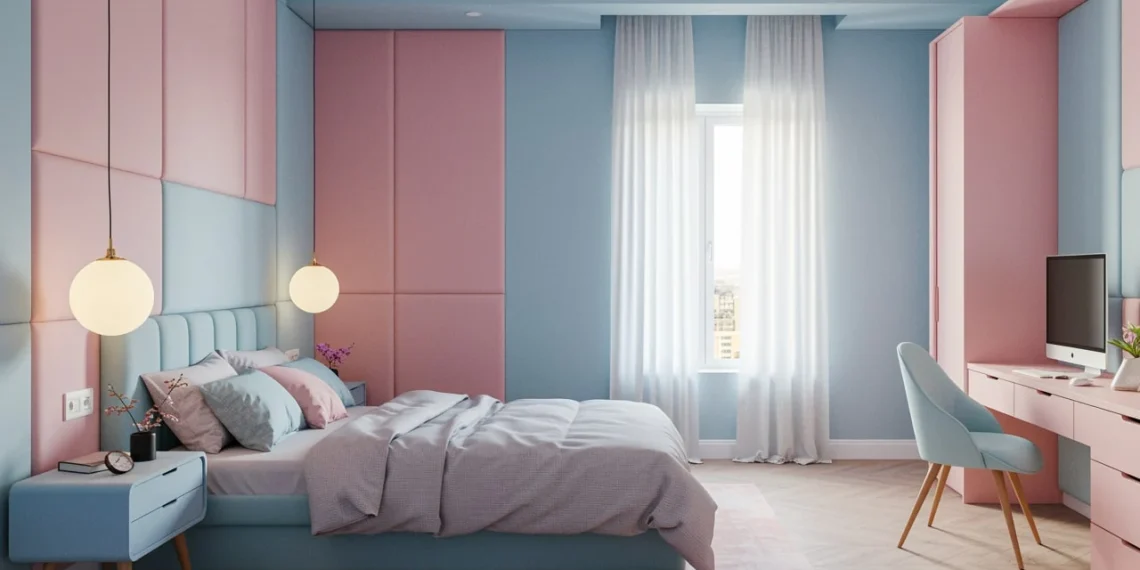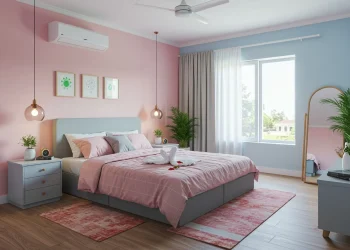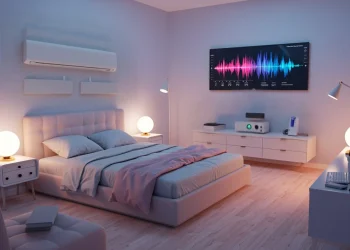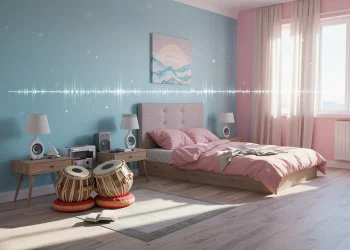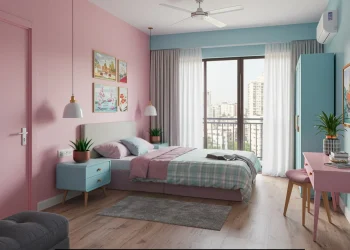Why Sound Matters More Than Ever for Quality Sleep
In bustling Indian cities like Mumbai, Delhi, and Bangalore, finding true silence has become nearly impossible. The constant symphony of traffic horns, construction work, and neighborhood activities creates a challenging environment for restorative sleep. Yet, our ancient wisdom has always recognized the profound connection between sound and sleep quality.
Modern sleep research validates what our ancestors knew intuitively: the right audio environment can dramatically improve sleep quality, while the wrong sounds can fragment our rest and leave us feeling exhausted. Whether it’s the gentle hum of white noise for sleep, carefully curated sleep music, or the natural sleep sounds that have soothed humans for millennia, creating your personal audio sanctuary isn’t just luxury—it’s essential for optimal health and well-being.
This comprehensive guide explores how to transform your bedroom into a sound sanctuary that honors both scientific research and traditional Indian practices. From understanding the neurological impact of different frequencies to implementing practical solutions for urban noise challenges, you’ll discover how to harness the power of sound for deeper, more restorative sleep.
The Science of Sleep Sounds: How Audio Environments Shape Our Rest
Understanding Sleep Stages and Sound Sensitivity
Sleep isn’t a uniform state—it’s a complex cycle of different stages, each with unique characteristics and sound sensitivities. During light sleep stages (N1 and N2), our brains remain partially alert to environmental sounds, making us vulnerable to disruptions. Research published in the Journal of Sleep Research shows that sounds above 35 decibels can cause micro-awakenings, fragmenting sleep even when we don’t consciously remember waking up.
Deep sleep (N3) and REM sleep require different acoustic considerations. During deep sleep, our brain waves slow dramatically, and consistent, low-frequency sounds can actually enhance the quality of this restorative stage. REM sleep, when most vivid dreaming occurs, shows increased sensitivity to sudden sound changes, making consistent audio environments particularly crucial.
The Neurological Basis of Sound Therapy
When we hear sounds, our auditory cortex processes the information and sends signals throughout the brain. Sleep sounds work by providing what researchers call “auditory masking”—consistent background noise that covers up disruptive environmental sounds. But the benefits go deeper than simple masking.
Specific frequencies can trigger the release of neurotransmitters associated with relaxation and sleep. Low-frequency sounds (below 100 Hz) have been shown to increase slow-wave sleep activity, while certain rhythmic patterns can synchronize with natural brainwave frequencies, promoting deeper rest.
Research on White, Pink, and Brown Noise
Scientific studies have revealed distinct benefits for different types of noise:
White Noise for Sleep: Contains equal energy across all frequencies, creating a consistent “shushing” sound. A 2017 study in Frontiers in Human Neuroscience found that white noise improved sleep quality in 38% of participants and reduced the time needed to fall asleep by 23%.
Pink Noise: Emphasizes lower frequencies while maintaining higher ones at reduced intensity. Research from Northwestern University demonstrated that pink noise can enhance deep sleep and improve memory consolidation during rest.
Brown Noise: Focuses on even lower frequencies, creating a deeper, more rumbling sound. While research is still emerging, early studies suggest brown noise may be particularly effective for individuals with ADHD or anxiety-related sleep difficulties.
Measuring Sleep Sound Effectiveness
The effectiveness of sleep audio isn’t just subjective—it can be measured through polysomnography studies that track brain waves, heart rate, and breathing patterns. Successful sleep sounds typically:
- Maintain consistent volume levels (avoiding sudden spikes or drops)
- Feature frequencies between 20-80 Hz for masking effectiveness
- Continue throughout the entire sleep cycle without interruption
- Gradually fade or continue at low volumes during early morning hours
Traditional Indian Sound Practices: Ancient Wisdom for Modern Sleep
The Sacred Science of Mantras and Chants
Long before modern sleep research, Indian traditions recognized the profound impact of sound on consciousness and rest. The practice of chanting specific mantras before sleep wasn’t merely spiritual—it was a sophisticated form of sound therapy that modern science is only beginning to understand.
The “Om” mantra, when chanted at specific frequencies (typically around 136.1 Hz), creates vibrations that resonate with the body’s natural rhythms. Research conducted at the All India Institute of Medical Sciences found that participants who practiced mantra meditation before sleep showed improved sleep quality and reduced cortisol levels.
Traditional bedtime mantras like “Shanti Path” or the gentle repetition of “So Hum” create what neuroscientists now recognize as meditative states that naturally transition the brain toward sleep-ready brainwave patterns. The rhythmic nature of these chants helps regulate breathing and heart rate, creating ideal physiological conditions for rest.
Temple Bells and Acoustic Healing
The distinctive sound of temple bells isn’t coincidental—it’s based on sophisticated understanding of sound frequencies and their impact on human consciousness. Traditional Indian bronze bells produce a unique harmonic series that includes both fundamental tones and overtones specifically designed to create peaceful mental states.
The frequency range of temple bells (typically between 200-400 Hz) falls within what modern acoustics calls the “golden frequency range” for relaxation. When these sounds fade gradually, they create what researchers term “acoustic decay patterns” that mirror the brain’s natural transition into sleep states.
Regional Lullaby Traditions and Their Modern Applications
India’s diverse lullaby traditions offer a treasure trove of sleep-inducing musical patterns. From the gentle “Chandamama Door Ke” of Hindi traditions to the rhythmic patterns of Tamil “Thalelo” songs, these melodies incorporate specific musical elements that promote sleep:
- Descending melodic patterns that mirror the brain’s relaxation process
- Consistent 4/4 or 3/4 time signatures that synchronize with resting heart rates
- Repetitive lyrical structures that create meditative states
- Gentle volume dynamics that gradually decrease toward silence
Modern sleep music producers increasingly incorporate these traditional elements, creating sleep music that honors cultural heritage while meeting contemporary needs for effective sleep audio.
Modern Sleep Audio Solutions: Technology Meets Tranquility
White Noise: Technical Benefits and Applications
White noise for sleep has become one of the most researched and widely adopted sleep audio solutions. Unlike the random noise pollution of urban environments, therapeutic white noise provides consistent, predictable sound that helps the brain “tune out” disruptive environmental audio.
The technical benefits of white noise include:
Frequency Masking: White noise covers the entire audible frequency spectrum, making it particularly effective at masking sudden sounds like car horns, slamming doors, or conversations that might otherwise cause sleep disruptions.
Neurological Habituation: Regular exposure to consistent white noise helps the brain develop habituation patterns, reducing sensitivity to environmental sound changes during sleep.
Stress Reduction: Studies show that white noise can reduce cortisol production and activate the parasympathetic nervous system, creating ideal conditions for restorative sleep.
Best Devices and Apps for Indian Users
When selecting white noise solutions for Indian homes, consider factors like power stability, humidity resistance, and noise pollution levels typical in urban areas:
Dedicated White Noise Machines:
- Look for devices with battery backup to handle power fluctuations
- Choose models with volume ranges suitable for apartment living (30-70 dB)
- Ensure devices can run continuously for 8+ hours without overheating
Smartphone Apps:
- Popular options like Sleep Cycle, Calm, and Noisli offer customizable white noise
- Look for apps that work offline to avoid interruptions from network issues
- Choose apps with timer functions and gradual volume adjustment features
Smart Home Integration:
- Voice-activated devices can provide consistent white noise through the night
- Smart speakers with sleep-specific features like gradually decreasing volume
- Integration with home automation systems for optimal timing
Volume and Frequency Optimization
Effective white noise requires careful attention to volume and frequency settings. For most adults, the optimal volume range falls between 40-50 decibels—loud enough to mask disruptive sounds but quiet enough to avoid interfering with natural sleep processes.
Frequency optimization depends on your specific environment:
- Urban apartments: Emphasize mid-to-high frequencies (200-2000 Hz) to mask traffic and neighbor noise
- Ground floor locations: Focus on lower frequencies (20-200 Hz) to address rumbling sounds from vehicles and construction
- Shared living spaces: Use directional white noise that focuses sound toward the sleeper while minimizing impact on others
Safety Considerations for Long-term Use
While white noise is generally safe for nightly use, long-term considerations include:
Hearing Protection: Ensure volume levels never exceed 70 decibels, and take periodic breaks from white noise to maintain natural hearing sensitivity.
Dependency Concerns: Gradually introduce white noise rather than relying on it immediately every night, allowing for flexibility when traveling or staying in different environments.
Device Maintenance: Regular cleaning of white noise machines prevents dust accumulation that could affect sound quality or create health concerns.
Nature Sounds: Connecting with India’s Natural Heritage
Nature-based sleep sounds offer a gentler alternative to synthetic white noise while connecting us with India’s rich natural heritage. These sounds work by triggering evolutionary relaxation responses—our brains are naturally programmed to find certain natural sounds soothing and safe.
Rain Sounds for Monsoon Comfort: The sound of gentle rainfall triggers deep relaxation responses rooted in our evolutionary past. For Indians, monsoon rains carry additional cultural significance, representing renewal, abundance, and natural cycles. Rain sounds typically feature:
- Consistent pink noise characteristics that mask other environmental sounds
- Natural volume variations that create interesting but non-disturbing audio patterns
- Association with cooler temperatures and reduced activity, mentally preparing for rest
Ocean Waves for Coastal Region Residents: Ocean sounds offer rhythmic patterns that naturally synchronize with breathing and heart rate. The consistent ebb and flow of waves creates what researchers call “binaural rhythm entrainment,” helping regulate autonomic nervous system function for optimal sleep conditions.
Forest Sounds for Urban Stress Relief: Gentle forest ambience—including rustling leaves, distant bird songs, and soft wind—provides what environmental psychologists term “attention restoration.” These sounds help urban dwellers mentally disconnect from city stress and reconnect with natural rhythms that promote restorative sleep.
Musical Therapy: Curated Sleep Playlists
Classical Indian Music for Sleep: Traditional Indian ragas were specifically designed to evoke particular emotional and physiological states. Certain ragas are particularly effective for sleep promotion:
- Raga Bageshri: Known for its calming effect and association with late evening
- Raga Puriya Dhanashri: Creates peaceful, contemplative moods ideal for pre-sleep relaxation
- Raga Sohini: Associated with early morning but also effective for deep nighttime rest
Contemporary Instrumental Options: Modern sleep music draws from various traditions while incorporating scientific insights about tempo, harmony, and rhythm for optimal sleep induction:
- Tempo: Effective sleep music typically features 60-80 beats per minute, matching resting heart rates
- Harmony: Simple, consonant harmonies avoid complex musical tensions that might stimulate mental activity
- Instrumentation: Gentle instruments like flute, sitar, piano, or strings create soothing tonal qualities
Binaural Beats and Their Effectiveness: Binaural beats involve playing slightly different frequencies in each ear, creating a perceived “beat” frequency that can influence brainwave patterns. Research suggests specific frequencies may promote different sleep stages:
- Delta waves (0.5-4 Hz): Associated with deep sleep and physical restoration
- Theta waves (4-8 Hz): Linked with light sleep and REM activity
- Alpha waves (8-13 Hz): Promote relaxation and pre-sleep states
While research on binaural beats shows promise, individual responses vary significantly, and they work best when combined with other sleep hygiene practices.
Urban Noise Management: Practical Solutions for City Living
Dealing with Traffic and City Sounds
Indian cities present unique noise challenges that require targeted solutions. Traffic noise, characterized by sudden honking, engine acceleration, and brake sounds, creates precisely the type of unpredictable audio environment that disrupts sleep most severely.
Frequency-Specific Masking: Traffic noise typically peaks in mid-frequency ranges (500-2000 Hz), making pink noise or brown noise more effective than standard white noise for masking these sounds. Position sound sources between your bed and the primary noise source (usually windows facing streets) for maximum effectiveness.
Window Treatment Strategies:
- Heavy curtains or drapes: Can reduce noise by 5-10 decibels while also blocking light
- Double-glazed windows: Most effective but expensive; can reduce noise by 20-25 decibels
- Weatherstripping: Inexpensive solution that seals gaps around windows and doors
Strategic Furniture Placement:
- Position your bed as far as possible from noise sources
- Use bookshelves, wardrobes, or other large furniture as sound barriers
- Consider room layout changes that put bathrooms or closets between bedrooms and noise sources
Neighbor Noise Mitigation Strategies
Apartment living often means dealing with neighbor activities that can disrupt sleep. Different types of neighbor noise require different approaches:
Footsteps and Movement (Impact Noise):
- Use thick rugs or carpets to absorb sound vibrations
- Rearrange furniture to create buffer zones between your bed and shared walls
- Consider earplugs designed specifically for side sleepers if other solutions prove insufficient
Television and Music (Airborne Noise):
- Sleep sounds or white noise can effectively mask consistent neighbor audio
- Acoustic panels or heavy wall hangings can absorb sound transmission
- Respectful communication with neighbors often yields better results than confrontation
Late-Night Activities:
- Combination approaches work best: personal audio environment plus basic soundproofing
- Focus on creating a “sound cocoon” around your sleep area rather than trying to eliminate all external noise
- Develop backup sleep strategies for particularly disruptive periods
Construction and Industrial Noise Solutions
Construction noise presents special challenges due to its intensity, unpredictability, and typically occurring during traditional sleep hours in rotating shift environments.
Temporary Solutions:
- High-volume white noise specifically designed to mask construction sounds
- Combination of earplugs and environmental sound masking
- Alternative sleeping arrangements during particularly intensive construction periods
Long-term Adaptations:
- Schedule flexibility to accommodate construction hours when possible
- Investment in higher-quality sound mas
